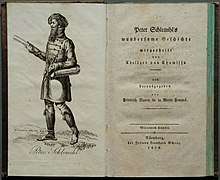Peter Schlemihl
Peter Schlemihl is the title character of an 1814 novella, Peter Schlemihls wundersame Geschichte (Peter Schlemihl's Miraculous Story),[1] written in German by exiled French aristocrat Adelbert von Chamisso.
 First edition frontispiece | |
| Author | Adelbert von Chamisso |
|---|---|
| Original title | Peter Schlemihls wundersame Geschichte |
| Translator | Leopold von Loewenstein-Wertheim |
| Country | Germany |
| Language | German |
Publication date | 1814 |
| ISBN | 978-1-84749-080-3 |
| OCLC | 246906885 |
Plot
In the story, Schlemihl sells his shadow to the Devil for a bottomless wallet (the gold sack of Fortunatus), only to find that a man without a shadow is shunned by human societies. The woman he loves rejects him, and he himself becomes involved in guilt. Yet when the devil wants to return his shadow to him in exchange for his soul, Schlemihl, as the friend of God, rejects the proposal and throws away the bottomless wallet besides. He seeks refuge in nature and travels around the world in scientific exploration, with the aid of seven-league boots. When overtaken with sickness, he is reconciled with his fellow men, who take care of him, and in regard for his sickness do not look for his shadow. Finally, however, he returns to his studies of nature and finds his deepest satisfaction in communion with nature and his own better self.[2]
Reception and cultural influence
The story, intended for children, was widely read and the character became a common cultural reference in many countries. People generally remembered the element of the shadow better than how the story ended, simplifying Chamisso's lesson to the idiom "don't sell your shadow to the Devil."
The Yiddish word schlemiel—borrowed from Hebrew shlumi'el—refers to a hopelessly incompetent person, a bungler. Consequently, the name is a synonym of one who makes a desperate or silly bargain. Originally the name meant friend of God, Theophilus.[2]
Later retellings
The story was performed on American television, in a 1953 episode of Favorite Story, starring DeForest Kelley as the title character.[3]
Georges Schwizgebel's 2004 paint-on-glass animation L'Homme sans ombre (The Man With No Shadow) portrays a slight variation on the original story: after being rejected by his lover and society, the main character returns to the devil. Rather than getting back his shadow, he trades his riches for a pair of seven-league boots and travels the world in search of a place where he will be accepted without a shadow. In the end, he becomes a Wayang shadow puppeteer in Indonesia because he can manipulate the puppets directly without affecting their silhouettes.[4]
Editions
- von Chamisso, Adelbert (2011), Peter Schlemihls wundersame Geschichte, Franziska Walther illus, Mannheim: Kunstanstifter, ISBN 978-3-942795-00-5, with 25 two-tone illustrations.[5]
See also
- Die Frau ohne Schatten (1919), opera by Richard Strauss to a libretto by Hugo von Hofmannsthal, partly based on the Scandinavian fairy tale "The Woman Who Had No Shadow".
- Lord Dunsany (1926), The Charwoman's Shadow (novel)
References
- Price, Nigel (18 December 1998), "Reflections on a Shadowless Man", Moonmilk (archives), URTH, 22 (59), retrieved 25 March 2008.
-

- Halliday, Karen (2003), "Your favorite story", DeForest Kelley – 1953 (annotated filmography), KL Halliday, retrieved 5 August 2017.
- Schwizgebel, Georges (2004), "L'Homme Sans Ombre", Google YouTube (in French), Studio GDS, the National Film Board of Canada, and Télévision Suisse Romande, retrieved 8 October 2009
- Gerdes, Claudia (2011). "Illustrationen zu Chamisso". Page Online. Retrieved 8 June 2011.
![]()
External links
![]()
- von Chamisso, Adelbert, Haldane, Michael (ed.), The Wonderful History of Peter Schlemihl.
- ———, The Wonderful History of Peter Schlemihl (translation), George Cruikshank (illustrator), Project Gutenberg.